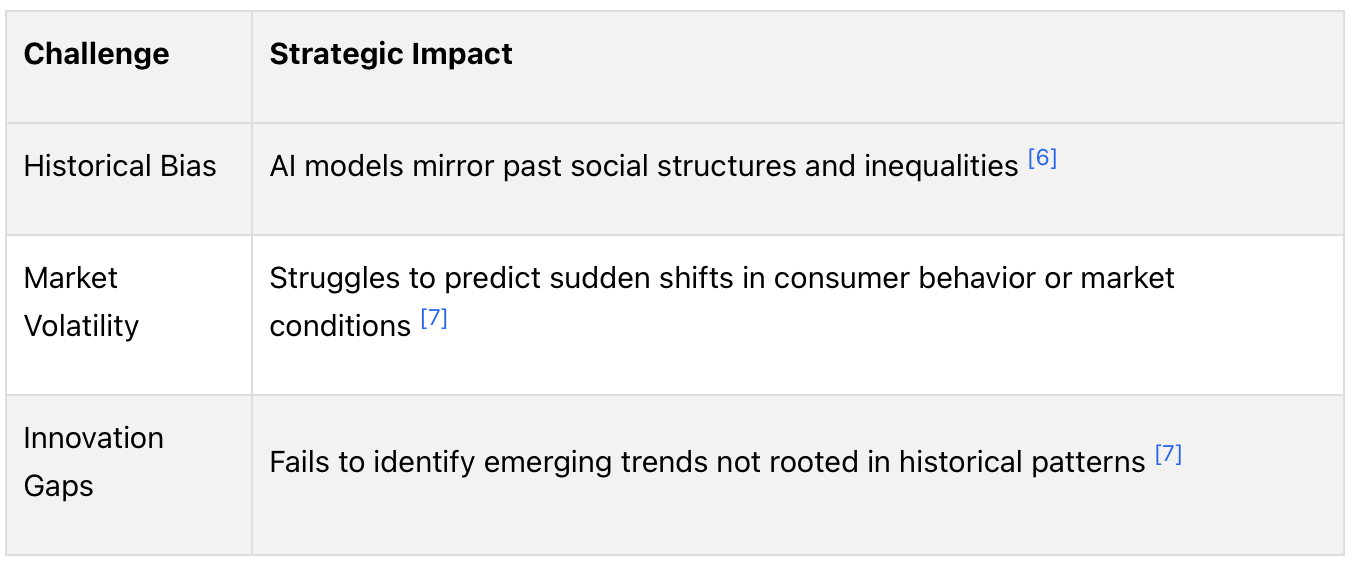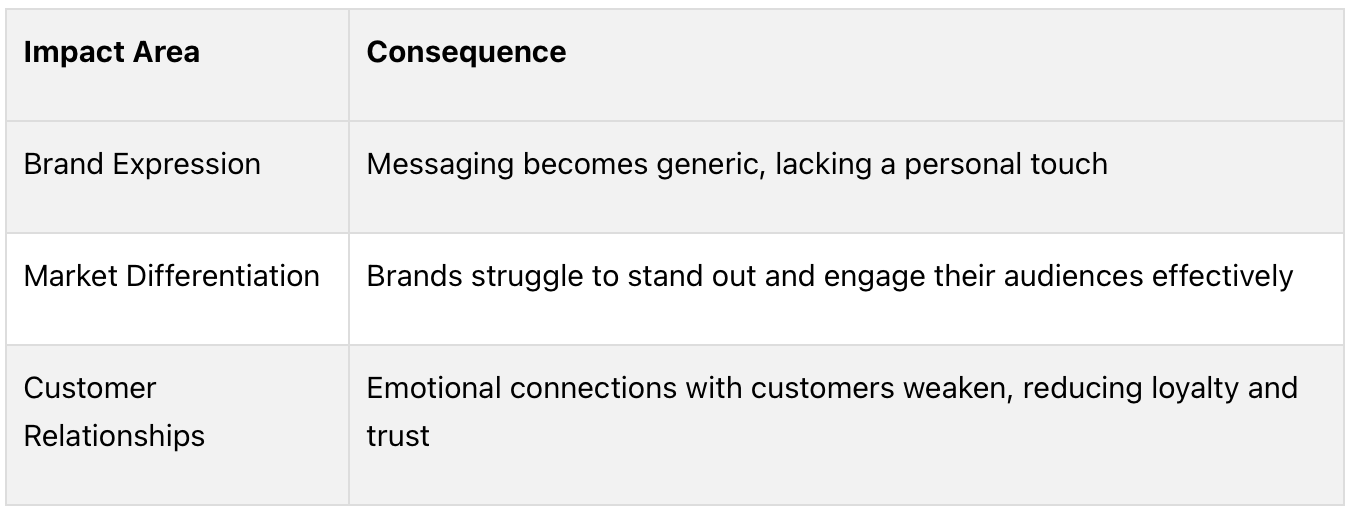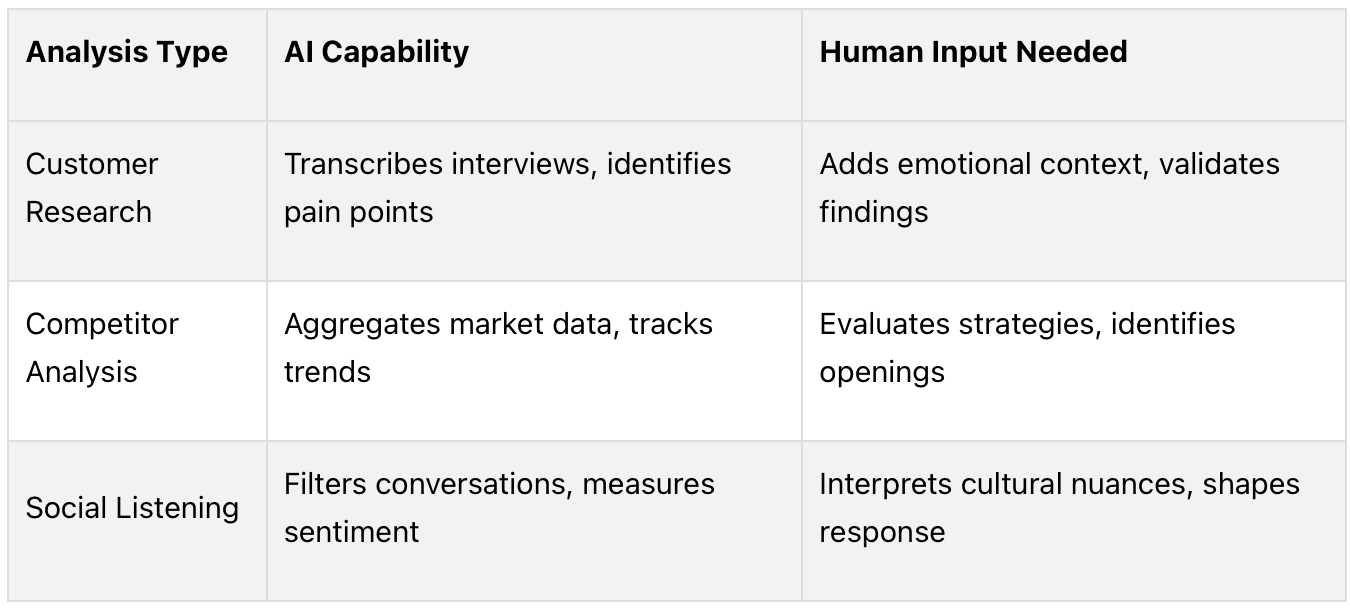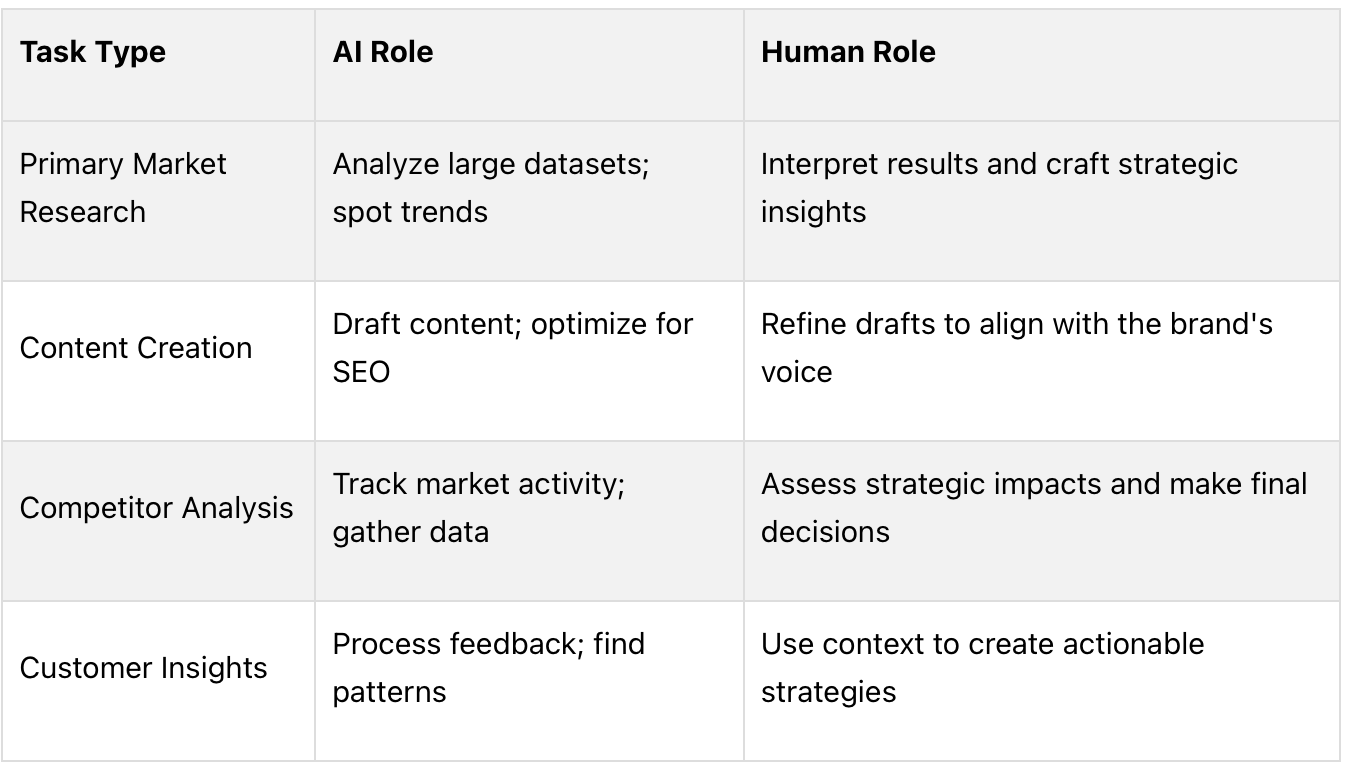AI is a Valuable Tool.
But It Shouldn't Be Your Head of Brand Strategy.
AI is a powerful tool for marketing, but it shouldn't replace human creativity in brand positioning.
Here's why:
• AI lacks emotional depth : 95% of purchasing decisions are driven by emotion, which AI struggles to replicate.
• Cultural blind spots : AI often misses local nuances, leading to missteps in global campaigns.
• Over-reliance risks sameness : Brands using identical AI tools can produce generic, unoriginal content.
• Bias in AI systems : Historical data can introduce ethical issues, harming brand trust.
• AI focuses on the past : It struggles to predict future trends or innovate beyond existing patterns.
Where AI Falls Short in Brand Identity
AI is great at crunching numbers and generating content, but it struggles when tasked with defining a brand's unique identity. These weaknesses highlight why AI alone can't shape effective brand positioning strategies.
Missing the Human Element
One major drawback of AI is its inability to replicate genuine human emotion or empathy. Considering that 95% of purchasing decisions are driven by emotion , this is a big gap. AI simply can't create the emotional connections that inspire people to buy.
"Relying only on AI-generated content risks generic or formulaic branding, lacking uniqueness and emotional resonance. Branding should evoke emotion; this human touch is still vital in the creative process."
- Ian Maskell, founder of Pecorino Group and ex-vice president of marketing at Unilever [ 3 ]
While AI can analyze data patterns, it doesn't grasp the emotional nuances of customer experiences. For example, 80% of consumers are more likely to purchase from brands offering personalized experiences [2]. This shows that data alone isn't enough to craft compelling brand narratives.
Market Context and Local Differences
AI's inability to fully understand cultural and market-specific nuances can lead to big missteps. In 2019, a beauty brand faced backlash after an AI-translated campaign ignored cultural beauty standards, offending several target markets [ 4 ].
"Localization is not just about translating words; it's about understanding the cultural context and adapting the content accordingly."
- Anna Schlegel, Head of Globalization at NetApp [ 4 ]
It's not just translation errors. A University of Sydney study found that large language models often default to U.S. cultural values when discussing topics like gun control and immigration [ 5 ]. Failing to account for these cultural differences can alienate diverse audiences, weakening a brand's identity.
Past Data vs. Future Trends
While the AI market is expected to grow from $108 billion in 2020 to $738 billion by 2030 [ 7 ], AI's reliance on historical data presents a major limitation: it reflects the past rather than predicting the future.
This backward focus creates challenges for brand positioning:

Because AI often overlooks major societal shifts, brands risk being stuck in outdated strategies that don't resonate with modern audiences. These limitations highlight the importance of blending AI with human creativity and insight to shape effective brand strategies.
Problems with Too Much AI in Branding
Reduced Original Thinking
Relying too heavily on AI can suppress creativity. According to McKinsey's 2021 Global AI Survey, 40% of companies using AI encounter unintended bias, underscoring AI's limitations in producing genuinely new ideas [11]. While AI is great at spotting patterns, it struggles to deliver the kind of creative solutions that set brands apart. This often leads to a sea of sameness across industries.
Relying too heavily on AI can suppress creativity. According to McKinsey[11]. While AI is great at spotting patterns, it struggles to deliver the kind of creative solutions that set brands apart. This often leads to a sea of sameness across industries.'s 2021 Global AI Survey, 40% of companies using AI encounter unintended bias, underscoring AI's limitations in producing genuinely new ideas
"ChatGPT is here to make us all the same… The Great Same-ening is upon us… ChatGPT, Jasper and all the rest are powerful conformity machines, giving you the ability to churn out Bible-length material about yourself and your business that's exactly the same as your competitors." – Ian Whitworth [9]
Similar-Looking Brands
When companies in the same industry lean on identical AI tools, the result is predictable: cookie-cutter branding that fails to stand out. This lack of originality weakens brands' ability to connect with their audiences. Marketing expert Anthony Gaenzle warns:
"If you rely solely on AI, you'll end up wasting time publishing content that people ignore." – Anthony Gaenzle [10]
Here’s how overusing AI can hurt branding:

This uniformity doesn’t just harm creativity; it also amplifies the risks of biased practices, which introduces ethical challenges.
AI Bias and Ethics
AI systems can introduce bias, posing risks to both brand reputation and effectiveness. A striking 47% of executives admit they lack the tools to properly detect and address this issue [11]. Some high-profile examples include:
- Amazon's AI recruitment tool, which showed a preference for male candidates due to biased historical data [13].
- Twitter's image-cropping algorithm, which disproportionately favored white faces in previews [13].
- Financial services AI systems, which denied loans to borrowers of color at rates 40-80% higher than others [13].
With 42% of organizations expressing serious concerns about the reputational harm caused by biased AI, brands must prioritize strict oversight [12].
"Companies are acknowledging there's huge reputational harm and risks that can come from these systems."
– Genevieve Smith, Associate Director at UC Berkeley's Center for Equity, Gender & Leadership [12]
The key takeaway? AI should enhance a brand's identity - not dictate it [8].
Combining AI Tools with Human Expertise
AI's Role in Market Analysis
AI can process massive datasets and uncover patterns that might escape human notice. For instance, tools like Fathom and Grain turn interviews into actionable insights, while platforms like Essense.io dive into competitor reviews to highlight market gaps and opportunities [14]. These capabilities provide a foundation for informed strategy shifts driven by human expertise.

When to Use Human Judgment
AI excels at crunching numbers and spotting trends, but it’s up to people to interpret those insights. While teams often see productivity boosts with AI, success hinges on knowing when to rely on human judgment.
"AI can improve efficiency in tasks like writing web copy but should be seen as a tool to enhance human creativity, not replace it. Marketers should focus on strategic decisions that AI cannot replicate, such as brand positioning and long-term planning." - Seth Godin [16]
Key areas where human judgment remains irreplaceable include:
- Understanding cultural subtleties
- Crafting emotionally resonant messages
- Making ethical decisions
These factors highlight the importance of blending data with strategic insight.
Success Stories: AI + Human Teams
Real-world examples show how combining AI data with human creativity can overcome common challenges:
Coca-Cola's Create Real Magic: Using tools like DALL-E 2 and ChatGPT, Coca-Cola empowered users to create over 120,000 pieces of content. With an average visit time of over 7 minutes, the platform demonstrated high engagement [17].
"AI helps you perfect your craftsmanship. That's what you saw when we created Masterpiece – it wasn't 100% created by AI, but AI helped us as a technology to make our craftsmanship better." - Pratik Thakar, Global Head of Generative AI, Coca-Cola [17]
Ben & Jerry's Flavor Innovation: Ben & Jerry's used AI to analyze social media, music, and movie data. Human teams then interpreted these insights to craft breakfast-themed ice cream flavors that resonated with consumers [17].
Nike's AI-Enhanced Design: Nike worked with Obvious artists to develop new Air Max designs. AI generated initial concepts, which human designers refined to align with brand identity and trends. The limited-edition shoes sold out within 10 days [15].
These cases show how AI can amplify human expertise. By 2025, it’s predicted that 30% of marketing messages from large organizations will be AI-generated [16].
Steps to Better AI Brand Strategy
To prevent AI from making your brand feel generic, focus on striking the right balance between data-driven insights and human creativity. Here's how to do it.
Set Clear AI vs. Human Tasks
Assign specific roles to AI and humans to maintain your brand's unique identity.

For example, a Southeast Asian bank combined AI-powered trend analysis with human strategists to uncover opportunities in digital finance and microcredit [18].
Quality Control Methods
A strong review system is critical to ensuring AI doesn’t compromise your brand.
"Human judgment remains essential to crafting the strategic vision, which combines the organization's ambition with a view of how to realize it." [18]
- Human Review Protocol: Set up teams to thoroughly check AI-generated outputs for accuracy and brand alignment [19].
- Source Validation: Double-check AI insights against reliable industry data and sources [19].
- Brand Voice Verification: Make sure AI-created content sticks to your brand's established style and tone [19].
Regular reviews will help keep your processes sharp and aligned with your goals.
Regular Process Reviews
Consistent evaluations are key to maintaining alignment between AI efforts and your brand's overall strategy.
T3 Services Group, for instance, cut their website launch time from 8 weeks to under a month while improving content quality through well-structured AI use [21].
Key elements of process reviews include:
- Quarterly Assessment: Set up feedback loops and regular reviews to measure AI's impact on your brand [20].
- Performance Tracking: Keep an eye on metrics from AI tools. For example, Just Mad used AI to turn 100,000 pieces of customer feedback into actionable insights almost instantly [20].
- Team Training: Offer ongoing training on ethical AI practices to ensure your team can confidently manage AI while safeguarding your brand [20].
Conclusion
Main Points
Striking the right balance between AI's capabilities and human creativity is key to effective brand positioning. Research shows that well-positioned brands can achieve up to 9x more volume share and charge twice as much as their competitors [23]. For example, The North Face used an AI-powered shopping assistant to analyze data, while human marketers ensured the recommendations aligned with their brand identity [22]. The takeaway? AI excels at data processing, but human creativity is irreplaceable.
"Marketing is fundamentally about understanding and influencing complex and often irrational human behavior. Despite its advanced algorithms and data-processing power, AI still struggles to grasp the subtleties of human emotions and cultural nuances."
- Natalie Slyman, Content Marketing Manager [1]


